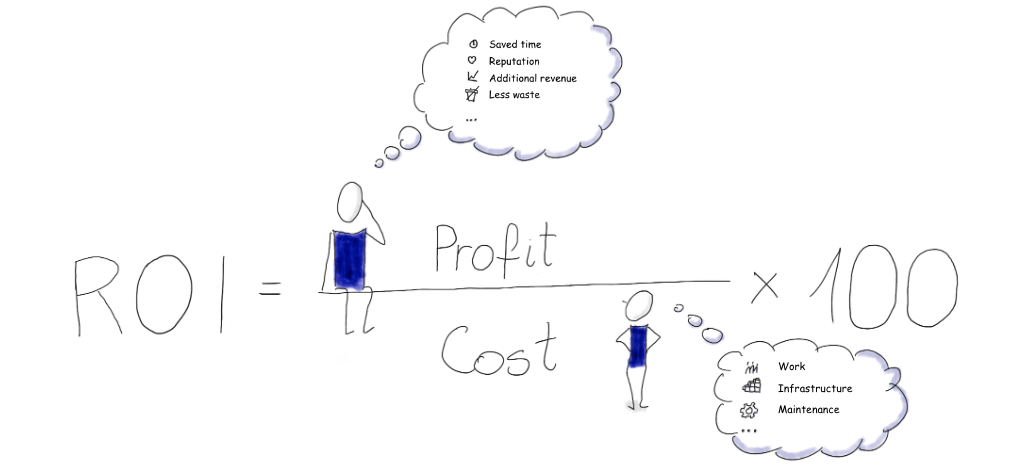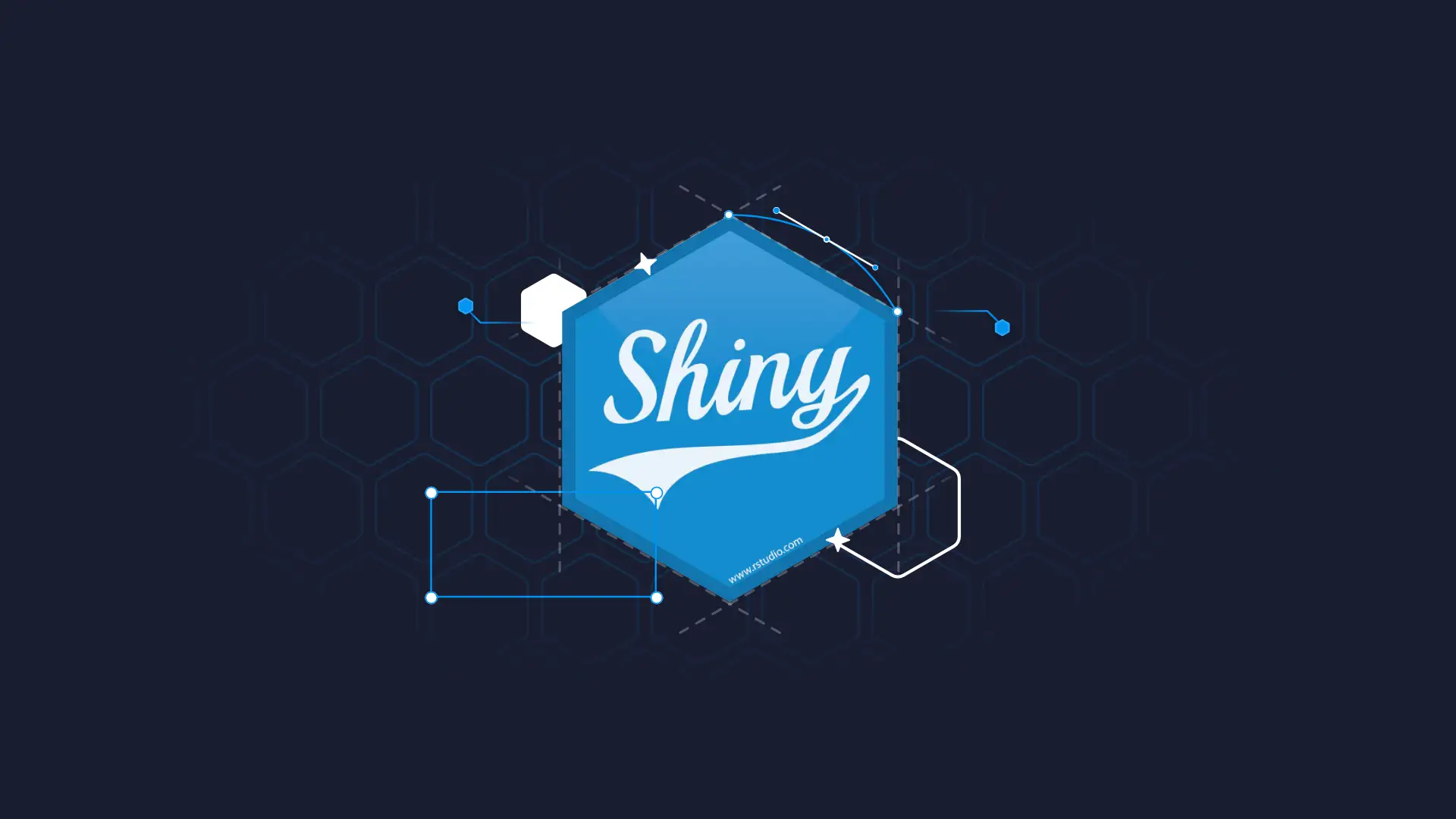
Presenting a compelling case for investing in your app idea to your boss or senior decision makers can be challenging. If you’ve never done it before, you’ll likely need to express an anticipated Return on Investment (ROI). Perhaps you’ll estimate the time required: “it will take me 3 weeks” or “I have a proposal from Appsilon to build it by X timeframe.” You also likely highlight the app’s benefits: “it will generate presentation-ready graphs” or “the process will be automated, saving our team’s time.”
If this sounds familiar and you were met with a “no”, let’s take a moment to put ourselves in the shoes of management. Let’s think from their perspective. What they likely heard was the cost along with a vague justification for that cost.
From the start, we intentionally used the word invest. And your app should be seen as just that – an investment. The company is choosing to allocate resources (whether money or an employee’s time) with the anticipation of significant financial gains in return. These financial benefits can be either increased revenue, or cost reduction.
To effectively communicate with management, accurately evaluate your projects, and construct compelling arguments that win support for your ideas, continue reading. Feel free to share your experiences in the comment section.
Return on Investment (ROI) and How to Calculate It
Return on Investment (ROI) is one of the most widely recognized financial indicators. It provides a straightforward perspective on the relation between profit and the cost of investment. The formula to calculate ROI is as follows:
ROI = (Profit / Cost) x 100
A higher ROI signifies a greater benefit to your company.

You can use ROI as a lagging indicator to evaluate if the investment in app development was profitable. ROI allows you also to compare different initiatives using the same common denominator – money. You can compare ROI of different apps, or even ROI of an app versus ROI of a team working on the process that can be automated with this app. You can also use ROI, as a benchmark to estimate the ROI of new similar projects.
Understanding the Importance of ROI in Shiny App Projects
When presenting an app idea, focusing on return on investment (ROI) can be a game-changer. ROI serves as a crucial metric that speaks the language of business decision makers. Instead of merely discussing costs, which may sound like an expense, framing your proposal around ROI demonstrates that the app is a strategic move that can deliver substantial value.
Next, we’ll show you how to calculate the ROI for your project, but first take 30 seconds to think about your project from two points:
- Identify Potential Gains: Begin by pinpointing the specific ways your app will contribute to the company’s growth. Will it attract new customers? Streamline internal processes? Enhance user engagement? Clearly define the areas where your app will make a positive impact.
- Quantify Benefits: Assign measurable values to the anticipated benefits. For instance, if the app aims to increase revenue, estimate the potential increase in sales. If it’s about cost reduction, calculate the projected savings.
Actual vs Anticipated ROI for Shiny Development
ROI revolves around profit and cost evaluations, but it doesn’t mean that you can only calculate it solely post-project completion (actual ROI). Even before the project starts, you can calculate with expected values (anticipated ROI). The formula is the same, but instead of actual profit and costs, you use your best estimations of anticipated costs and profits (e.g. using values from past similar projects as benchmarks). It’s a great tool to use when presenting an app idea to potential business sponsors.
When projecting anticipated ROI, it’s important to be clear about the assumptions that you are making. In this case, you don’t have real data yet, but if you can show how you are estimating the numbers, you increase both the accuracy of your estimates and your reliability in the eyes of the sponsors. For example, you may not know how many users will use the app. While you might lack precise data, leveraging data from a comparable app within the company, directed towards the same team, can provide insights into projected user adoption for the new app. This strategic use of existing data fortifies the foundation of your estimations, bolstering their reliability and fostering confidence among stakeholders.
Calculating anticipated ROI in advance and then checking it versus the actual ROI is also a great exercise. On one hand it lets you do the evaluation upfront. Start with the goal in mind and then decide if the app will be a success and worth investing more in. Or conversely if it performs below the expectations and it’s better to abandon any further investment. On the other hand, it also gives you insight to improve future estimates of anticipated ROIs – check in which assumptions you were overly optimistic and adjust them next time.
How to Calculate ROI for Your R Software Project
Let’s deep dive into the ROI formula. In the numerator, we find profit – simply, revenue minus cost. Our focus will be on revenue, as cost calculation will be covered in the next section. In order to calculate ROI, you need to calculate financial revenue. This can be either additional money earned, or cost(s) saved.
In some cases this calculation will be straightforward. Consider an app optimizing manufacturing processes, reducing waste and leading to a quantifiable measure of waste reduction and cost savings. Typically, you’ll select a period of time for which you’ll calculate the ROI. For example, you could calculate how much less waste is produced throughout a single year. Make sure to match the time period to your case; elongated periods like 5 years or more, may suit high initial investments with revenue growth over time
In other cases, estimating the revenue can be much more sophisticated. Sometimes this is because the app doesn’t directly generate revenue, or cut costs. In these cases, an app may influence other important factors. That’s why we like to think about ROI in the form of different currencies, like time, reputation, or values. Even if not directly monetary, these currencies can still be translated into financial revenue. Below are ideas on how to convert these diverse currencies into monetary terms.
ROI Currency Types: R Shiny Project Examples
1. ROI Currency: Time
Many of the apps that we develop for our clients aim to automate the processes and hence save time of manual work of the team. It’s not directly convertible to financial savings. However, you can still estimate it with the following steps:
- First, try to measure how much time a single usage of the app saves versus the manual equivalent.
- Then multiply it by the number of times the app is used in a given time period.
- Finally, estimate the financial savings by multiplying the time saved with the average employee cost in the team using the app.
Don’t worry if the single time saving is small. With numerous app users, the aggregate savings can amount to thousands of dollars.
For apps that automate processes, additional benefits can also be estimated:
- lower rotation rate in the team (as team members don’t need to do a lot of boring manual work),
- higher quality work (manual processes are usually prone to errors that may be also very costly to the company), and
faster reaction to emerging risks (risks can be easily raised by an automated system and team members have more time to tackle those issues that actually need to be taken care of, rather than following manual process to discover the risk in the first place)
2. ROI Currency: Reputation
We can use the example of the Appsilon website redesign, our goal was to show our clients the case studies, our portfolio and services. As a result we expected our clients to perceive us as professionals and experts in the field. Beneficial impact on a company’s image is mostly non-financial, that being said, having the right image attracts the right clients. In this sense, we can estimate a financial ROI.
The reputation can bring revenue in several ways:
- more sessions with the same conversion rate,
- higher conversion rate, or
- increased deal value.
Knowing the average deal value before and after the change and measuring how the sessions number and conversion rate we can easily estimate the additional revenue out of the changes that improved the reputation.
3. ROI Currency: Values
Mbaza is an AI-powered app that classifies camera-trap images to preserve wildlife in Gabon and Kenya. Wildlife conservation and biodiversity preservation generate positive impacts, and actions contributing to these goals return value.
Camera traps are used to monitor wildlife worldwide. The data they gather aids conservation efforts and identifies threats, like illegal hunting or logging. To do this they generate hundreds of thousands of images. The challenge is to classify them quickly and accurately in remote locations.
Mbaza offers increased accuracy and accelerated processing of large amounts of images, up to 3200% faster than manual classification. This acceleration lowers the data processing time from weeks to hours. In doing so, it also drastically lowers costs of labeling large datasets, empowering conservationists and government officials to achieve better results with fewer resources. And the best part is, by design it operates fully offline, on an ordinary laptop, making it fit for use in remote areas. But the resources saved with Mbaza are not the primary return. The true value is the outcome of each project in which it is implemented.
To date, Mbaza AI has classified more than 500,000 images, helping to protect endangered species in African forests and savannas.
We an approach the estimation of Mbaza’s ROI in two ways:
- We can estimate monetary savings – from billable hours for manual classification to subscription costs or resource loss from delayed responses.
- The other approach is more challenging, but is just as important – ethical value. In this approach, we would need to estimate how many animals were saved and relate a tangible value to those lives.
How to Calculate Software Project Costs for ROI
Costs are generally easier to calculate than revenue. Nonetheless, there are some aspects that are worth remembering when calculating the cost.
Staffing Costs
In the realm of software development, labor expenses are the primary cost factor. Remember that the cost of work not only encapsulates what a company pays to the software partner, but also covers the cost of people from within your company. For example, a Product Owner that is usually appointed from your team, should have a significant amount of time allocated to work with the developers and future users to ensure the success of the app.
Infrastructure Costs
Whether the app is hosted on premises or on the cloud, there are underlying costs associated. Make sure to include these in the calculations. Infrastructure costs can also be optimized; optimizing the virtual machines usage, or even optimizing the app, so that it uses less resources.
Maintenance Costs
As each software product requires some maintenance to keep it alive, maintenance costs are mentionable. Maintenance covers resolving minor issues, software updates, or even data updates. Whether you do it on your own, or have a software partner to support maintenance – you should reflect this cost in the calculations.
Constructing a Compelling Case for Shiny ROI
Build your case around the calculated ROI. Show decision makers that the investment in app development is a strategic move aligned with the company’s goals. Emphasize how the app’s benefits will contribute to revenue growth or cost savings. Use concrete figures and projections to validate your claims.
By showcasing a clear understanding of the financial implications and potential returns, you’re more likely to secure buy-in for your app development project.
We Are Here to Help
It isn’t an easy task to estimate the benefits of custom software development. Nevertheless, the ability to communicate in a way that resonates with decision makers and present data that can be directly compared to competing projects holds immense significance.
At Appsilon, our dedication to your project is focused on delivering an effective product as smoothly as possible. Together we achieve success by:
- Measuring app adoption, deriving insights that inform ongoing improvements.
- Enhancing user experience with refined app interfaces and interactions, leading to heightened user satisfaction and efficiency.
- Extending comprehensive support, including crafting compelling marketing materials that effectively convey the app’s value.
- Collaborating closely with Product Owners, by quantifying the app’s financial benefits to empower you to secure the necessary funding for further project development.
Remember, effective communication about ROI can transform how your app ideas are perceived. When you focus on the tangible benefits and align your proposal with the company’s financial objectives, you’re positioning your app for success in the eyes of decision makers.


